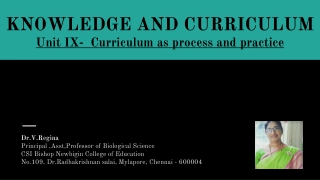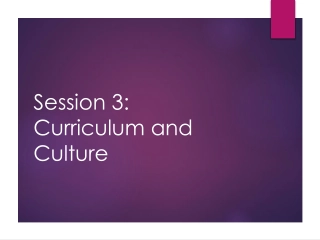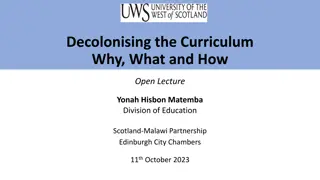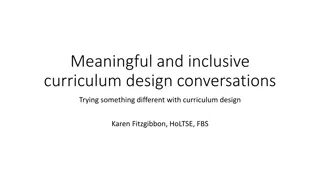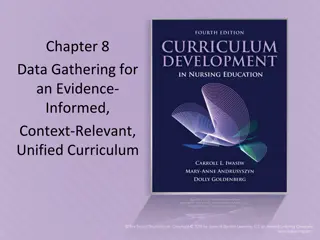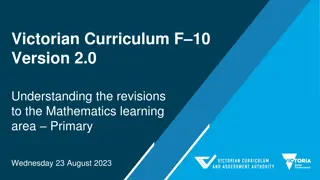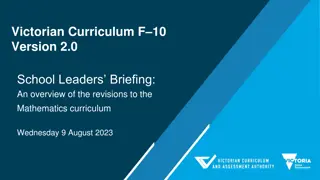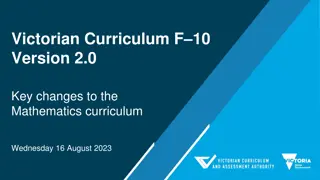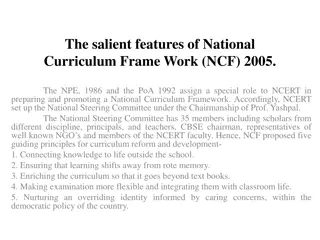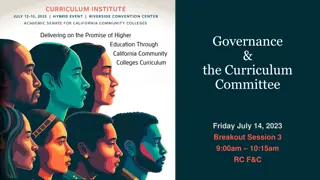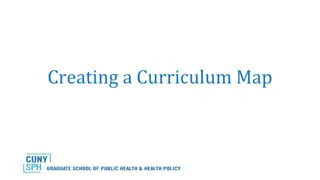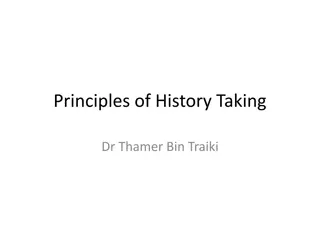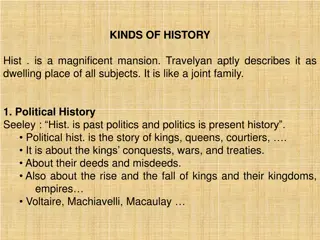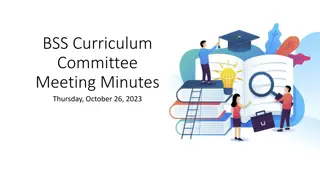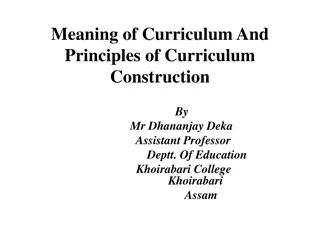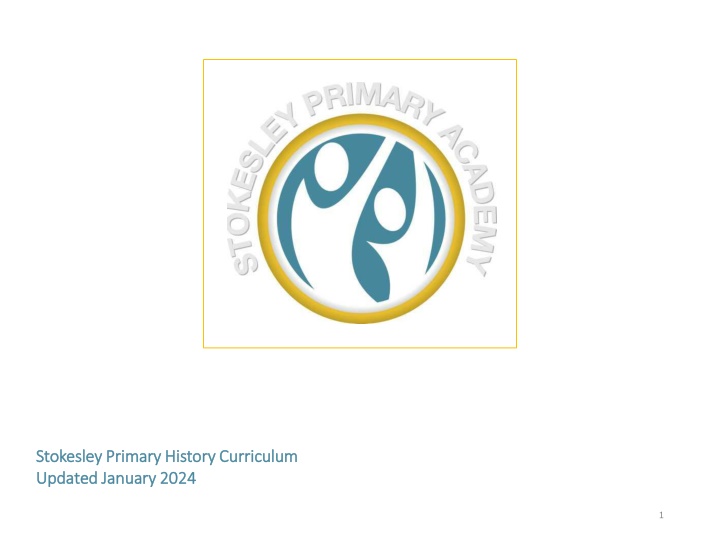
Inspiring History Curriculum at Stokesley Primary
Discover how Stokesley Primary's History Curriculum sparks curiosity in pupils, nurtures historical thinking skills, and explores key events and voices. From dinosaurs to the Romans, Vikings, and more, students journey through time to understand the world's shaping forces. With a focus on chronology, civilization, and legacy, the curriculum cultivates a love for history and empowers children to think critically and historically. Explore the engaging progression of knowledge and skills from Early Years to Year 6, making meaningful connections to real-life contexts along the way.
Download Presentation

Please find below an Image/Link to download the presentation.
The content on the website is provided AS IS for your information and personal use only. It may not be sold, licensed, or shared on other websites without obtaining consent from the author. If you encounter any issues during the download, it is possible that the publisher has removed the file from their server.
You are allowed to download the files provided on this website for personal or commercial use, subject to the condition that they are used lawfully. All files are the property of their respective owners.
The content on the website is provided AS IS for your information and personal use only. It may not be sold, licensed, or shared on other websites without obtaining consent from the author.
E N D
Presentation Transcript
Stokesley Primary History Curriculum Stokesley Primary History Curriculum Updated January 2024 Updated January 2024 1
Our History Curriculum inspires pupils to think, read, speak and write like historians and develop a lifelong curiosity about past events and forgotten voices. It is designed to open our pupils eyes to the way the world we live in today has been shaped. Our History Curriculum is built around the progression of the following big ideas : Chronology Chronology Invasion Invasion Civilisation Civilisation Legacy Legacy Monarchy Monarchy Religion Religion During a pupil s journey from Y1 to Y6, our History Curriculum builds on the Knowledge and Understanding of the world our children develop across EYFS. We have carefully designed and sequenced our History Curriculum which clearly sets out the vocabulary, knowledge and skills pupils gain at each stage of their learning journey so that pupils progress well over time. Our curriculum has been built using the following components: Declarative Knowledge (knowledge of the past) and Disciplinary Knowledge (knowledge of how historians investigate the past). Our aims are to provide a broad, balanced History Curriculum that ensures the development of a historical understanding of Britain s past and that of the wider world. Our curriculum ensures that pupils develop not only their historical knowledge, skills and vocabulary but a love for history that will remain with them for the rest of their lives. The aims of history in our school are: To enable children to know about significant events in British and world history and to appreciate how things have changed ov To enable children to know about significant events in British and world history and to appreciate how things have changed over To develop a sense of chronology. To develop a sense of chronology. To help children understand society and their place within it, so that they develop a sense of their local heritage. To help children understand society and their place within it, so that they develop a sense of their local heritage. To develop in children the skills of enquiry, evaluation, interpretation and presentation enabling them to think as historian To develop in children the skills of enquiry, evaluation, interpretation and presentation enabling them to think as historians. s. We ensure that children have as many opportunities as possible to make meaningful links to real life contexts and experiences We ensure that children have as many opportunities as possible to make meaningful links to real life contexts and experiences. er time. time.
History Overview EYFS Year 1 Year 2 Year 3 Year 4 Year 5 Year 6 How do we know about dinosaurs? Stone Age to the Iron Age: What was life like, and how do we know? What was the impact of the Roman Empire on Britain? What is the legacy of the Greeks on British history? Raiders or Settlers: how should we remember the Vikings? Getting to know you Harvest Bears Celebrations and festivals Autumn Which early transport would you choose? Who was most important? Mary Seacole or Florence Nightingale? Who was James Cook and why was he so important in history? What does our local history tell us? Why did the Anglo-Saxons invade Britain? Birds and Winter Feelings and Fantasy Spring What did the Ancient Egyptians achieve? What was it like to live during the Victorian Era in Britain? Why do we study the Maya in history? Living things Under the sea Summer Summer 3
KS1 Lower KS2 Upper KS2 Icon Theme EY To know that there were different reasons for invading Britain. To understand that there are varied reasons for coming to Britain. To know that there are different reasons for migration. To know that settlement created tensions and problems. To understand the impact of settlers on the existing population. To understand the earliest settlements in Britain. To know that settlements changed over time. To understand there are increasingly complex reasons for migrants coming to Britain. To understand that migrants come from different parts of the world. To know about the diverse experiences of the different groups coming to Britain over time. Invasion To understand how invaders and settlers influence the culture of the existing population. To understand that society was organised in different ways in different cultures and times and consisted of different groups with different roles and lifestyles. To know that education existed in some cultures, times and groups. To understand the changes and reasons for the organisation of society in Britain. To understand how society is organised in different cultures, times and groups. To be able to compare development and role of education in societies. To be able to compare education in different cultures, times and groups. To understand the changing role of women and men in Britain. To understand that there are differences between early and later civilisations. Civilisation To know some inventions that still influence their own lives today (e.g. bicycles and how they have changed over time) To know some achievements and discoveries of significant individuals (e.g. explorers). To begin to identify achievements and inventions that still influence their own lives today (e.g. travel). To know the legacy and contribution of some inventions (e.g. flight). To be aware of the achievements of significant individuals (e.g. those involved with the history of flight) To be able to identify achievements and inventions that still influence our lives today from Roman times. To know the legacy and contribution of the Anglo-Saxons and Vikings to life today in Britain. To be aware of the achievements of the Ancient Egyptians. To understand that people in the past were as inventive and sophisticated in thinking as people today. To know that new and sophisticated technologies were advanced which allowed cities to develop. To understand the impact of war on local communities. To know some of the impacts of war on daily lives. To understand that people in the past were as inventive and sophisticated in thinking as people today. To know that new and sophisticated technologies were advanced which allowed cities to develop. To recognise some interests and achievements from their own lives and the lives of their families and friends. Legacy
To know that a monarch in the UK is a king or queen. To begin to understand that power is exercised in different ways in different culture, times and groups e.g. monarchy. To know that Britain was organised into kingdoms, and these were governed by monarchs. To understand the development of groups, kingdom and monarchy in Britain. To know who became the first ruler of the whole of England. To understand the expansion of empires and how they were controlled across a large empire. To understand that societal hierarchies and structures existed including aristocracy and peasantry. To understand some reasons why empires fall/collapse To understand how the monarchy exercised absolute power. To understand the process of democracy and parliament in Britain. To understand that different empires have different reasons for their expansion. To understand that there are changes in the nature of society. To know that there are different reasons for the decline of different empires. To know that in fairy tales kings/queens are usually important, powerful people who rule over others. Monarchy To understand that there are different beliefs in different cultures, times and groups. To know about paganism and and the introduction of Christianity in Britain. To know how Christianity spread. To compare the beliefs in different cultures, times and groups. To be aware of the different beliefs that different cultures, times and groups hold. To understand the changing nature of religion in Britain and its impact. To be aware of how different societies practise and demonstrate their beliefs. To be able to identify the impact of beliefs on society. Religion Sequencing three or four events in their own life (e.g. birthday, starting school, starting Year 1). Using common words and phrases for the passing of time (e.g. now, long ago, then, before, after). Sequencing three or four artefacts/photographs from different periods of time. Placing events on a simple timeline. Recording on a timeline a sequence of historical stories heard orally. Sequencing up to six photographs, focusing on the intervals between events. Placing events on a timeline, building on times studied in Year 1. Beginning to recognise how long each event lasted. Knowing where people/events studied fit into a chronological framework. Sequencing events on a timeline, referring to times studied in KS1 to see where these fit in. Understanding that history is divided into periods of history e.g. ancient times, middle ages and modern. Using dates to work out the interval between periods of time and the duration of historical events or periods. Using BC/AD/Century. Sequencing eight to ten artefacts, historical pictures or events. Beginning to develop a chronologically secure knowledge of local, British and world history across the periods studied. Placing the time studied on a timeline. Using dates and terms related to the unit and passing of time e.g. millennium, continuity and ancient. Noticing connections over a period of time. Making a simple individual timeline. Sequencing events on a timeline, comparing where it fits in with times studied in previous year groups. Understanding the term century and how dating by centuries works. Putting dates in the correct century. Using the terms AD and BC in their work. Using relevant dates and relevant terms for the period and period labels e.g.Stone Age, Bronze Age, Iron Age, Romans, Anglo-Saxons, Vikings, Romans, Tudors, Greeks, Aztecs, and Victorians Developing a chronologically secure understanding of British, local and world history across the periods studied. Placing the time, period of history and context on a timeline. Relating current study on timeline to other periods of history studied. Comparing and making connections between different contexts in the past. Sequencing 10 events on a timeline. Beginning to sequence events when describing them (e.g. daily routines, events in a story) Recognising that some stories are set a long time ago. Recognising significant dates for them (birthday). Beginning to use common words and phrases for the passage of time, even if using inaccurately (e.g. yesterday, today, tomorrow, last week, when I was in nursery... ) Recounting activities that happened in their past using photos as a prompt. Chronology
History in the Foundation Stage: ELG: Past and Present Children at the expected level of development will: Talk about the lives of the people around them and their roles in society; Know some similarities and differences between things in the past and now, drawing on their experiences and what has been read in class; Understand the past through settings, characters and events encountered in books read in class and storytelling. At Stokesley Primary Academy pupils are taught: About changes within living memory, describing memories that have happened in their own lives; How to begin to make sense of their own life-story and family s history. That there are similarities and differences between people; About the roles of significant people in the community. Links to the National Curriculum 2 year olds learn to: Nursery learn to: Reception learn to: Chronological understanding Notice differences between people; Make connections between the features of their family and other families; Understand simple questions about who , what and where ; Listen to simple stories and understand what is happening, with the help of the pictures; Repeat words and phrases from familiar stories; Ask questions about a book; Finish off key phrases from well known books. Continue to develop positive attitudes about the differences between people. Begin to make sense of their own life-story and family s history; Begin to show interest in different occupations. Understand simple questions about who , what , where and why ; Enjoy listening to longer stories and can remember much of what happen; Know many rhymes, be able to talk about familiar books, and be able to tell a long story. Use words and phrases: first, next, day, night, old, new; Understand and talk about seasonal changes; Talk about similarities and differences between themselves, people in their family and the community; Discuss past and upcoming events from familiar situations Can talk about past and present experiences in their lives for example festivals within different communities and their own; Remember and talk about parts of stories, sequencing key parts.
Links to the National Curriculum 2 year olds learn to: Nursery children learn to: Reception children learn to: Historical Enquiry Makes comments and shares their own ideas. Develop play around favourite stories using props. Engage in extended conversations about stories, learning new vocabulary. Use talk to organise themselves and their play: Let s go on a bus... you sit there... I ll be the driver. Begin to describe a sequence of events, real or fictional, using words such as first , then... Plant seeds and care for growing plants, talking about the changes they observe over time Look at and talk about books, pictures and artefacts from the past (e.g., baby toys) Observe growth and decay over time - observe an apple core going brown and mouldy over time - help children to care for animals and take part in first-hand scientific explorations of animal life cycles, such as caterpillars a& chick eggs. Comment on images of familiar situations in the past Listen to and talk about selected non-fiction to develop a deep familiarity with new knowledge and vocabulary. Organising and communicating Describe events in some detail (e.g. Before school I had a lovely breakfast ) (C&L) Use talk to help work out problems and organise thinking and activities explain how things work and why they might happen (C&L) Retell stories, once they have developed a deep familiarity with the text; some as exact repetition and some in their own words (C&L) Links to the National Curriculum 2 year olds learn to: Nursery children learn to: Reception children learn to: Historical interpretation Identify and talk about some elements of stories and non-fiction texts.
Long-term overview for History YEAR 1 Who was more important Mary Seacole or Florence Nightingale? National Curriculum Chronological understanding Historical interpretation Historical enquiry Organising and Communicating Sequence some events or 2 related objects in order Use words and phrases: old, new, young, days, months Remember parts of stories and memories about the past Identify and recount some details from the past from sources (e.g. pictures, stories) Find answers to simple questions about the past from sources of information (e.g. pictures, stories) Show knowledge and understanding about the past in different ways (eg. role- play, drawing, writing, talking). 8
Long-term overview for History YEAR 1 Who was more important Mary Seacole or Florence Nightingale? Who was Florence Nightingale? Who was Mary Seacole? When did the Crimean War take place? Who was more important? How have their actions influenced our lives? What difficulties did both Mary Seacole and Florence Nightingale face? Declarative knowledge Disciplinary Knowledge Communication Key learning Evidence base Interpretation & significance Be able to understand the chronological timeline Begin to identify how things are same and different Understand why these women are significant Know how their actions influenced and changed future hospital practice understand this as a Legacy Identify and recount some details from the past from sources (e.g. pictures, stories) Begin to understand that some evidence related to past events is more reliable than others. History is learning about the past. Mary Seacole: A Jamaican nurse who travelled the world helping others. She nursed soldiers in the Crimean War. Verbally Answering simple questions using the key knowledge and vocabulary Label and simple recount Florence Nightingale: A British nurse who improved hospitals and saved soldiers lives in the Crimean War. Observe and handle artefacts and ask simple questions about the past. 9
Long-term overview for History YEAR 2 How do we know about dinosaurs? How has transport changed over time? Who was James Cook and why was he so important in history? National Curriculum Chronological understanding Historical interpretation Historical enquiry Organising and Communicating Recount changes in own life over time Put 3 people, events or objects in order using a given scale. Use words and phrases such as recently, before, after, now, later. Use past and present when telling others about an event Look at books and pictures (and eyewitness accounts, photos, artefacts, buildings and visits, internet). Understand why some people in the past did things. Look carefully at pictures or objects to find information about the past. Ask and answer questions such as: what was it like for a ....? , what happened in the past? , how long ago did .... happen? , Estimate the ages of people by studying and describing their features. Draw labelled diagrams and writes about them to tell others about people, events and objects from the past 10
Long-term overview for History YEAR 2 How do we know about dinosaurs? What is a fossil and what can they tell us about the past? When were dinosaurs alive? Who was Mary Anning and why is she important? How did Mary Anning change the understanding of the history of Earth? What happened to the fossils that Mary Anning found? Disciplinary Knowledge Declarative knowledge Communication Key learning Evidence base Interpretation & significance Begin to understand the chronological timeline Understand the significance of finding evidence of prehistoric life. Dinosaurs are prehistoric reptiles that have lived on Earth from about 228 million years ago Most fossils are formed when a living organism (such as a plant or animal) dies and is quickly buried by sediment (such as mud, sand or volcanic ash). Mary Anning, 1799-1847 was a famous fossil hunter. Her father showed her how to find fossils so they could sell them. It has been difficult for historians to trace many fossils that Mary Anning located. Mary s work contributed to classification of prehistoric life and challenged the story of creation found in the Bible. The children will work as history detectives and will use information independently from several different types of sources including written, visual and artefacts to answer historical questions. Use several different sources to select information about the key features of the life of Mary Anning. Identify at least one effect that Mary s discoveries had on the scientific world. recognise that Mary was a pioneer for girls to be scientists. Understand why Mary s discoveries were significant and why she is remembered today (Legacy). Mary s achievements were significant because she was a young girl from a poor family and at the time Science was dominated by rich older men. Assessment What is different between when Mary was alive and now? What do we now know because of Mary s discovery? Why was Mary s achievement so significant? 11
Long-term overview for History YEAR 2 How has transport changed over time? How have cars changed over time? What role did horses have in transport in the past? How have bicycles changed over time? What is the legacy from George Stephenson and Mae Jemison? How has international travel changed over time? How have trains changed over time? Disciplinary Knowledge Declarative knowledge Communication Key learning Evidence base Interpretation & significance Begin to understand the similarities and differences between past and present in relation to transport. understand the chronology of transport development and how this has impacted on the world today in terms of travel, industry and pollution. To consider the significanceand legacy of the work of George Stephenson and Mae Jamison Know that one of the first types of bicycles was named after the money one penny and a farthing and how bicycles have changed over time Most stage coaches were drawn by four horses. George Stephenson, a British civil engineer who was born in 1761, created the first public railway in 1825. Karl Benz designed and built the world s first practical automobile to be powered by an internal combustion engine. Mae Jemison was the first black, African American woman astronaut to travel into space. The invention of the aeroplane facilitated more accessible international travel and increased the speed of travel. The children will work as history detectives and will use information from several different types of sources including written, visual and artefacts to answer historical questions. Use several different sources to select information about transport and to compare and contrast things in the past and the present Identify at least one effect that George and Mae had on the world. Order the different types of transport chronologically Assessment How did George Stephenson make a difference to transport and our present lives? Why was Mae Jemison a significant figure from the past? Which transport came first? What impact does our present transport have on the world? 12
Long-term overview for History YEAR 2 Who was James Cook and why is he so important in history? What were his voyages like compared to life on board a ship now? Who was Captain Cook and how did he become a Captain? When was Captain Cook born in relation to other key people studied in history? What is the legacy of Captain Cook and why do we study him? When did Captain Cook s voyages take place? Disciplinary Knowledge Declarative knowledge Communication Key learning Evidence base Children will visit James Cook Museum and will use information from several different types of sources including written, visual and artefacts to answer historical questions. Recognise what is a reliable piece of information and what is not, e.g., photograph vs word of mouth. Interpretation & significance Point out a few similarities and differences between ways of life at different times. Captain James Cook was a famous English sea captain and explorer. He was born in 1728 and died in 1779. He was born in Marton near Middlesbrough and then moved to Great Ayton. When he was about 18 years old he travelled to Whitby and got a job working on the coal ships. He joined the Royal Navy in 1755 and learned about navigation and map drawing. Draw labelled diagrams and write about Captain Cook to tell others about people, events and objects from the past. Recognise why Captain Cook went on his voyage and explain what happened as a result. Begin to reflect on the significance of what has been learnt from the past. In 1770, Captain James Cook and his crew sailed the HMS Endeavour and discovered Australia, New Zealand, and Tahiti. In 1772 he came very close to the Antarctic, but they had to turn back because of the cold. His final voyage was to Hawaii where he was killed in 1779 aged 55. Explain the legacy of Captain James Cook and how he helped to develop a greater understanding of the geography of the world. Assessment How was Captain Cooks voyage different to life on board a ship now? What is the legacy of Captain Cook? Captain Cook is considered one of the greatest navigators and explorers of all time and mapped the east coast of Australia this paved the way for British settlement 18 years later. He created the first accurate map of the South Pacific. 13
Long-term overview for History YEAR 3 Stone Age to the Iron Age: What was life like and how do we know? What does our local history tell us? What did the Ancient Egyptians achieve? National Curriculum Chronological understanding Historical interpretation Historical enquiry Organising and Communicating To understand the term chronology. Use timelines to place events in order. Understands timeline can be divided into BC and AD. To begin to develop an understanding of duration. Discuss links with other civilisations and time periods. Use words and phrases: century, decade. Look at 2 versions of same event and identify differences in the accounts. Use printed sources, the internet, pictures, photos, music, artefacts, historic buildings and visits to collect information about the past. Use more than one source of evidence at once. Ask questions such as how did people .? What did people do for .? Suggest sources of evidence to use to help answer questions. Make deductions about the past from a source Present findings about past using speaking, writing, ICT and drawing skills. Use dates and terms with increasing accuracy. Use subject specific words e.g. monarch, settlement, invader. 14
Long-term overview for History YEAR 3 Stone Age to the Iron Age: What was life like and how do we know? What are the key differences between the Stone, Bronze and Iron Ages? What has helped us to build a picture of what happened during the Stone Age period? What was the significance of the discovery of iron ore and the invention of the wheel? Why was the creation of Iron Age hill forts so important? What do we mean by the term hunter-gatherer? Disciplinary Knowledge Declarative knowledge Communication Key learning Evidence base Know that much of what is presented as historical fact is based on limited information. Observe and use pictures, photographs and artefacts to learn about the past. Understand there are different types of evidence and sources that can be used to help us find out about what happened in the past Interpretation & significance Understand that significant discoveries or inventions changed people s lives, e.g., the wheel or iron ore. Start to compare two versions of a past event. Start to use stories or accounts to distinguish between fact and fiction Archaeologists have found artefacts as sites such as Skara Brae and Stonehenge to help them understand how people in Britain lived. Stone Age: weapons and tools made of stone which evolved in time and helped them with agriculture and more permanent settlements. Bronze Age: Weapons and tools made of bronze, helped to establish trade and make advancements in architecture and writing systems Iron Age: Stronger tools, weapons and wheels, more efficient farming and warfare, transportation and expansion of empires. Know what is meant by the term hunter-gatherer Hill forts helped with defence and to build communities To know the vocabulary: settlement, Iron Age fort, Skara Brae, Stonehenge, Archaeologists Put artefacts or information in chronological order from a long time ago. Use appropriate dates and chronological conventions, e.g., BC, BCE and AD, in the discussion. Uses subject-specific vocabulary such as settlements and archaeologists. Assessment Place the stone, bronze and iron age on a timeline Can explain the significance of iron ore Can compare and contrast stone age and present day 15
Long-term overview for History YEAR 3 What does our local history tell us? Which historic features tell us about Stokesley s past? What would a timeline of Stokesley s significant features look like? What changes have occurred in Stokesley comparing the past with the present How can we find out about people in the past? Which famous people have lived in Stokesley what is their legacy? Disciplinary Knowledge Declarative knowledge Communication Key learning Evidence base Know that much of what is presented as historical fact is based on limited information. Observe and use pictures, photographs and artefacts to learn about the past. Understand there are different types of evidence and sources that can be used to help us find out about what happened in the past Use gravestones, the cenotaph and census records to support Interpretation & significance Understand that local artefacts can tell us the significance of the past The waterwheel in Stokesley was used for milling grain powering a corn mill known a Fidler s Mill which played a significant role in the local economy grinding grain to flour. Stokesley show celebrates a history of agriculture Stokesley fair was originally established by a royal charter granted by Henry III The packhorse bridge Is from 17thCentury and is a grade II listed building. It helped to facilitate trade and travel across the region. There have been different schools in Stokesley with part of our Academy being a much earlier building. We can use evidence in our community to find out about its past, including gravestones, cenotaphs and the use of a census. To use the words and phrases Century and Decade Put artefacts or information in chronological order from a long time ago. Discuss key individuals from the past and explain their legacy. Assessment Share the historic features of Stokesely town Know at least two famous people who have lived in Stokesley and understand their legacy 16
Long-term overview for History YEAR 3 What did the Ancient Egyptians achieve? How have archaeologists helped us know what happened in Ancient Egypt and elsewhere? What was happening in Britain when the Ancient Egyptians were at their most powerful? How did the River Nile support Egyptian civilisation and settlement? How and why were the Ancient Egyptians influenced by their Gods? Why did the powerful Egyptians create a culture of slavery? Disciplinary Knowledge Declarative knowledge Communication Key learning Evidence base Interpretation & significance Recognise the impact that bias has on historical events. Know that historical recounts are prone to exaggeration and interpretation. That some artefacts can link to others to provide an overview of civilisation but that their significance is interpreted. Look at more than one version of the same event or story in history and identify differences. Know about the impact of a past action on our lives today. To share verbally the achievements of the Ancient Egyptians and the impact on current day life. Civilisation is a human society with its own social organisation, language, way of life and culture. Culture is a pattern of behaviour shared by a society or group of people. Many different things make up a society s culture. These things include food, language, clothing, tools, music, arts, customs, beliefs, and religion. The river Nile helped to establish settlement supporting agriculture, trade and travel. Hieroglyphic symbols in the form of pictures, are used in Ancient Egypt and form part of early communication systems. A Pharaoh was a king of ancient Egypt, and a social hierarchy appears to have existed. Pyramids - ancient stone buildings with four triangular sloping sides. The most famous pyramids are those built in ancient Egypt to contain the bodies of their kings and queens. The afterlife was considered important in Ancient Egypt and the process of mummification was used to prepare for this. Accounts from historians about Egyptian artefacts Pictures of pyramids and mummies Trip to Oriental Durham University museum to look at real artefacts 17
Long-term overview for History YEAR 4 What was the impact of the Roman Empire on Britain? Why did the Anglo-Saxons invade Britain? National Curriculum Chronological understanding Historical interpretation Historical enquiry Organising and Communicating To understand the concept of change over time. Use words and phrases: century, decade, BC, AD, after, before, during. Divide recent history into present, using 21st century, and the past using 19th and 20th centuries. Name and places dates of significant events from past on a timeline. To have a clear understanding of duration between events Give reasons why there may be different accounts of history. Understand the difference between primary and secondary sources of evidence. Use documents, printed sources, the internet, databases, pictures, photos, music, artefacts, historic buildings and visits to collect information about the past. Ask questions such as what was it like for a during ? Make deductions and justify with evidence. Suggest sources of evidence from a selection provided to use to help answer questions. Give reasons for/results of events and changes Present findings about past using speaking, writing, ICT and drawing skills. Use dates and terms with increasing accuracy. Use subject specific words e.g. monarch, settlement, invader. 18
Long-term overview for History YEAR 4 What was the impact of the Roman Empire on Britain? What did the Romans find when they first arrived in Britain? What evidence is there that the Romans came to Britain at all? How and why did the Romans conquer Britain? How has the Roman invasion impacted on modern day Britain? What did the Romans do to improve Britain? Disciplinary Knowledge Declarative knowledge Communication Key learning Evidence base Use of photographs of artefacts, Durham University selection of artefacts. Historians interpretations of the Roman Empire in order to compare and contrast. Archaelogical remains of towns and existing roads and buildings. Know the difference between primary and secondary sources. Interpretation & significance Recognise the impact that bias has on historical events. Know that historical recounts are prone to exaggeration and interpretation. That some artefacts can link to others to provide an overview of civilisation but that their significance is interpreted. Know about the impact of past actions on our lives today and record this in an appropriate way. The Roman Empire followed the Iron Age (link to tools and weapons) and that prior to invasion Britain was ruled by the most powerful group of people in Europe Celts. They lived in tribes (sharing the same culture and values). Julius Caesar invaded Britain in 55BC and 54BC to punish the tribes for helping his enemies. He also wanted gold, silver, zinc, lead and grain found in Britain. On his first attempt to conquer Britain he brought 10,000 men but did not defeat the Celtic warriors. On the second attempt he brought 25,000 troops also unsuccessful. Emperor Claudius sent 40,000 troops and elephants AD43 which defeated the Celts. Caractacus and later Queen Boudicca tried to fight back. Empire group of countries controlled by one ruler (emperor). Conquired Britain to expand the empire and grow grain to feed the army. Established roads to improve trade and communication. Created towns to settle down. The Romans introduced taxes, Latin (aiding communication), flushing toilets, imported different foods and provided a common currency. Many of these things remain a legacy in Britain today. 19
Long-term overview for History YEAR 4 Why did the Anglo-Saxons invade Britain? How did the Anglo-Saxons create different settlements to the ones the Romans had created? Where did the Anglo-Saxons originate from and when did they invade our country? How did the Anglo-Saxons bring about law and order to Britain? What did we learn about the Anglo-Saxons from the discoveries at Sutton Hoo? What do we know about many of the Anglo-Saxon kings? Disciplinary Knowledge Declarative knowledge Communication Key learning Interpretation & significance Evidence base Know about the impact of past actions on our lives today and record this in an appropriate way. To show the chronology of key historical periods of history Recognise the impact that bias has on historical events. Know that historical recounts are prone to exaggeration and interpretation and can be different. That artefacts can provide historians with indications about what life was like (Sutton Hoo) Have a clear understanding of the British timeline that extends from the Stone Age. Around AD400 the Romans who were ruling Britain left which meant the strong armies fending off foreign invaders were no longer there. This led to invasion attempts by tribes from different places. Collectively known as Anglo-Saxons the tribes (Jutes, Saxons and Angles) came from Germany, Denmark and the Netherlands, many wanted to leave their countries due to flooding. Many Anglo-Saxons arrived peacefully seeking land to farm, brining tools, weapons and farm animals, building new homes and settlements. They were skilled craftsmen. During the Anglo-Saxon period in Britain, there was no single ruler, and the Anglo- Saxons were not a unified tribe. Each group of Anglo-Saxon settlers had its leader or war chief. There were inequalities depending on your status. Laws were used to keep order. Roman settlements were around trade and cities, Anglo-Saxons were more rural around farming. Excavations at Sutton Hoo show simplistic open-plan living and skilled craftsmanship. Alfred the Great promoted education and books, he battled against the Vikings and then promoted peace so they could live alongside each other. Evidence and artefacts from Sutton Hoo including sites from homes that were built and artefacts relating to coins and battlewear Chronicles 31
Long-term overview for History YEAR 5 What is the legacy of the Greeks on British history? What was it like to live during the Victorian Era in Britain? National Curriculum Chronological understanding Historical interpretation Historical enquiry Organising and Communicating Use timelines to place and sequence local, national and international events. Sequence historical periods. Describe events using words and phrases such as: century, decade, BC, AD, after, before, during, Tudors, Stuarts, Victorians, era, period. Identify changes within and across historical periods. Look at different versions of the same event and identify differences in the accounts. To describe different accounts of an historical event, explaining some of the reasons why the accounts may differ. Know that people (now and in past) can represent events or ideas in ways that persuade others. Use documents, printed sources, the internet, databases, pictures, photos, music, artefacts, historic buildings and visits to collect information about the past. Ask a range of questions about the past. Choose reliable sources of evidence to answer questions. Realise that there is often not a single answer to historical questions. Suggest causes and consequences of some of the main events and changes in history. Present structured and organised findings about the past using speaking, writing, maths, ICT, drama and drawing skills. Use dates and terms accurately. Choose most appropriate way to present information to an audience. 21
Long-term overview for History Long-term overview for History YEAR 5 What is the legacy of the Greeks on British history? What evidence is there that the Ancient Greeks were more advanced than Ancient Britons? How were the Ancient Greeks influenced by their Gods? What did the Ancient Greeks introduce that we benefit from today? What were the main characteristics of the Spartans and the Athenians? Disciplinary Knowledge What was everyday life like for the Ancient Greeks? Declarative knowledge Communication Key learning Interpretation & significance Evidence base Know about the impact of past actions on our lives today and record this in an appropriate way. To show the chronology of key historical periods of history Understandthat significant discoveriesor inventions changedpeople s lives To know the chronology of the Ancient Greeks in relation to the Ancient Egyptians and Romans Athens and Sparta were, at one point, the two most powerful city-states in Ancient Greece; Athens was the largest city in the country and operated as a hub of the economic, political, financial, and cultural affairs in Greece. The city was also symbolic of freedom, art, and democracy for the civilised world. Sparta was the Dorian Greek military state, and was responsible for the protection of Greece. Sparta supplied a huge army to defend Greece for a number of years. Men in Sparta had to join the army and live in army barracks for most of their lives, which meant their wives and children rarely saw them. The men of Ancient Greece had full citizenship status and could vote, something women were not allowed to do. Mythology includes narratives about gods, goddesses, heroes, and mythical creatures, and it often serves to convey the values, beliefs, and cultural identity of a society. Know that much of what is presented as historical fact is based on limited information. Observe and use pictures, photographs and artefacts to learn about the past. Identify differences when comparetwo versionsof a past event, explaining why this might be. Understand there are different types of evidence and sources that can be used to help us find out about what happened in the past Startto usestoriesor accountsto distinguish between fact and fiction. Artefacts were decorated with pictures depicting (c) Focus Education (UK) Ltd events, helping us to understand events of the past. 22
Long-term overview for History YEAR 5 How did the Victorians influence our life today? What was life like for most children during the Victorian era? What do we mean by the term industrialrevolution ? How do we know what life was like for the Victorians? What was home life like for most people who lived during the Victoria era? How did the Victorian period impact on our lives today? Disciplinary Knowledge Declarative knowledge Communication Key learning Interpretation & significance Evidence base Know about the impact of past actions on our lives today and record this in an appropriate way. To show the chronology of key historical periods of history. To discuss different types of evidence and reason which is more reliable. Understandthat significant discoveriesor inventions changedpeople s lives To place the Victorians into chronological order relating to other key periods of history. The Victorian period refers to the time in Britain when Victoria was the Queen (1837-1901) Most people did not have access to electrical devices or cars but the period was a time of huge change, Britains population doubled and cities began to grow and thrive although demand for housing and food was high, leaving many in poverty. There were many new inventions including railways and factory machines, beginning the industrial revolution. During this time, Britain was to become the richest country in the whole world with the largest empire and this was ruled by Queen Victoria. Many children had to work and this was often dangerous. Schools had large classes and punishment was severe, initially only rich children attended, but laws were introduced to provide schools for the poor, in 1880 this changed to ensure that all children went to school until they were at least 10 years old. There was initially a distinct class system, people like Lord Shaftesbury and Dr Barnardo tried to improve children s lives. Know that much of what is presented as historical fact is based on limited information. Observe and use pictures, photographs and artefacts to learn about the past. Identify differences when comparetwo versionsof a past event, explaining why this might be. Understand there are different types of evidence and sources that can be used to help us find out about what happened in the past including paintings, drawings and novels such as Charles Dickens Oliver Twist. Startto usestoriesor accountsto distinguish between fact and fiction. (c) Focus Education (UK) Ltd A trip to Preston Park Museum with replica Victorian Streets 8
Long-term overview for History YEAR 6 Raiders or Settlers: how should we remember the Vikings? Why do we study the Maya in history? National Curriculum Chronological understanding Historical interpretation Historical enquiry Organising and Communicating Understand that the past has been represented in different ways. Suggest accurate and plausible reasons for how/why aspects of the past have been represented and interpreted in different ways. Know and understand that some evidence is propaganda, opinion or misinformation and that this affects interpretations of history. Identify and use different sources of information and artefacts. Evaluate the usefulness and accurateness of different sources of evidence. Select the most appropriate source of evidence for particular tasks. Form own opinions about historical events from a range of sources. Use sources of evidence to form hypotheses about the past. Independently select relevant source material for enquiry and justify choices. Present information in an organised and clearly structured way. Present information in the most appropriate way (e.g. written explanation/tables and charts/labelled diagram). Use of specific dates and terms. Use timelines to place events, periods and cultural movements from around the world. Use timelines to demonstrate changes and developments in culture, technology, religion and society. Use key periods as reference points: BC, AD, Romans, Anglo Saxons, Tudors, Stuarts, Georgians, Victorians and Today. Describe main changes in a period in history using words such as: social, religious, political, technological and cultural. Name date of any significant event studied from past and place it correctly on a timeline. 24
Long-term overview for History YEAR 6 Raiders or Settlers: how should we remember the Vikings? Who were the Vikings and why did they have a reputation of being fierce raiders? The Vikings were they fit to rule? What led to the downfall of the Vikings in Britain? What was the long-term impact of the Vikings on our lives today? Disciplinary Knowledge Declarative knowledge Communication Key learning Interpretation & significance Evidence base Understandthat significant discoveriesor inventions changedpeople s lives A timetline around the build up to the Battle of Stamford Bridge and the Battle of Hastings (1066). Use different sources from the time and make judgements over which are most trustworthy. The chronology of the Vikings invasion in relation to other key periods of history. 1066 was the end of Viking raiders in Britain after the death of the Norweigan King Harald Hardrada. There were any claims to the throne in this period. The Vikings were revolutionary ship builders and carpenters. The Vikings never fully conquered all of Britain s land. Parts of the English language have been influenced by the Norse language. Norse Mythology has given us stories relating to Gods and given an indication of their belief system. The Vikings picked up Christianity visiting Britain and took it back to Scandanavia. Consider different ways of checking the accuracy of interpretations of the past. Realise that there is often not a single answer to historical questions and use evidence to argue this. Identify differences when comparetwo versionsof a past event, explaining why this might be. Startto usestoriesor accountsto distinguish between fact and fiction. 1515
Long-term overview for History YEAR 6 Who were the Maya and what have we learned from them? How did the Maya become associated with the ball games pok-ta-pok? What evidence do we have that the Maya were an advanced civilisation? Who were the Maya and when and where did they live? What do we know of the rituals carried out by the Mayan civilisation? What caused the Mayan civilisation to disappear? Disciplinary Knowledge Declarative knowledge Communication Key learning Interpretation & significance Evidence base To know where the Maya appear on a timeline and understand the chronology of this time with other historical periods. Make links and comparisons to other civilisations (Egyptians, Greeks) The Mayan civilisation flourished in a region known as Mesoamerica spanning across Mexico and parts of Central America. The Maya constructed magnificent cities and excelled in celestial navigation constructing their cities as a reflection of the sky. They had an exceptional knowledge of astronomy. The Mayan belief in Gods created a culture of sacrifice. The Mayan game pok-ta-pok could be described as early football Mayan pyramids were constructed differently to those in Egypt and evidence their advanced civilisation. The legacy of the Maya is characterised by their elaborate architecture, distinct cuisine, and influential languages that have left a lasting impact on our present-day world. Codices were used as books to communicate. They developed the concept of zero and wrote what we call hieroglyphs (glyphs for short). Understandthat significant discoveriesor inventions changedpeople s lives Realise that there is often not a single answer to historical questions. Explore different artefacts and discuss what they might tell us. Explore the communication of word and number and how this has changed over time. Consider different ways of checking the accuracy of interpretations of the past Explain the impact of the Mayan period of history. Use specific dates and terms. Consider the impact and significance of the Mayan civilisation on the modern world. 26

